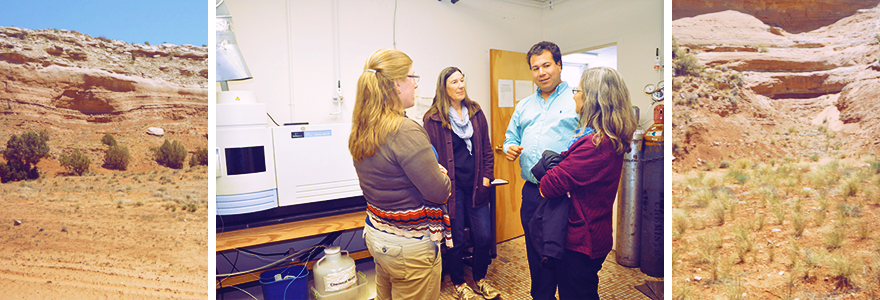NEWS
Reactivity of Metals in Abandoned Uranium Mines

On March 6, 2015, I had the privilege of listening to Uranium component team member José Cerrato (UNM) deliver a graduate seminar on his research, "Reactivity of Metals from Abandoned Uranium Mine Wastes in the Southwestern United States". With a background in biogeochemistry, José knows the value of geology, nanoscience, and interdisciplinary study; even though he is in the department of Civil Engineering at UNM, his research brings several disciplines together. For the first half of the seminar, Cerrato presented findings on work done in Southern Colorado involving in situ bioremediation of uranium in groundwater. Uranium bioremediation involves injecting an electron donor into the groundwater flow to induce Uranium reduction from U(VI)—highly soluble and posing a significant health risk—to U(IV), which can be used in nuclear fuel rods. At this point in his research, there is no evidence that U(IV) speciation is altered by geochemical conditions, but it does appear the characteristics of some biomass functional groups play a critical role in uranium reduction.
The second half of the seminar involved José's research for New Mexico EPSCoR. Working with Bruce Thomson, José and his team set out to determine how uranium moves in the environment, specifically near the Grants mineral belt and on the Navajo Nation. The team studied and collected samples area near Blue Gap, AZ, an area known to have high uranium concentration in spring water that is used by the small Blue Gap community (mine workers used to wash their hands in the spring). The team examined the samples using X-ray fluorescence, scanning electron microscopy, XANES (X-ray absorption near edge structure) spectroscopy, and EXAFS (extended X-ray absorption fine structure) spectroscopy. In a very small nutshell, the results showed the following:
- X-ray fluorescence: detected high Uranium elemental content in mine wastes tested;
- Scanning electron microscope: indicated presence of a uranium-vanadium phase;
- XANES spectra: confirmed presence of U(VI); and
- EXAFS spectra: confirmed presence of uranium-vanadium phase similar to carnotite, a highly radioactive mineral made of potassium, uranium and vanadium (chemical formula: K2(UO2)2(VO4)2·3H2O).
In response to a question posed at the seminar, José indicated that it has been difficult for scientists to track health issues related to exposure to radioactive materials in these areas. A lot of the science required simply isn't available, and the Navajo Nation is an independent nation with its own government and regulations. The Centers for Disease Control have several projects ongoing, but many are tainted with various biases. Uranium, just like arsenic, can be released into water under environmentally relevant conditions. José's work will continue with more sampling and investigation, and I look forward to another presentation about his research.
Pictured above: José (center, right), with Laura Crossey (center, left) and Johanna Blake (left), talks about equipment purchased with NM EPSCoR funding to NSF Program Officer Audrey Levine.


